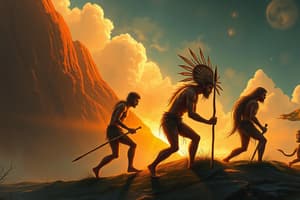Podcast
Questions and Answers
What process refers to the changes in cultures from simple to complex?
What process refers to the changes in cultures from simple to complex?
- Biological evolution
- Socio-cultural evolution
- Natural selection
- Cultural evolution (correct)
Natural selection increases the likelihood of less adaptive traits being passed on to future generations.
Natural selection increases the likelihood of less adaptive traits being passed on to future generations.
False (B)
What species is known as 'handyman' and is recognized as the first toolmaker?
What species is known as 'handyman' and is recognized as the first toolmaker?
Homo habilis
The trait where certain characteristics in a population survive and reproduce more effectively is called ___
The trait where certain characteristics in a population survive and reproduce more effectively is called ___
Match the hominid species with their characteristics:
Match the hominid species with their characteristics:
Which period is known as the transition from small nomadic bands to agricultural settlements?
Which period is known as the transition from small nomadic bands to agricultural settlements?
Homo sapiens lived during the Upper Paleolithic period and created specialized tools.
Homo sapiens lived during the Upper Paleolithic period and created specialized tools.
What evolutionary process focuses on the formation of new species?
What evolutionary process focuses on the formation of new species?
Every species tends to produce more individuals than can ___ to maturity.
Every species tends to produce more individuals than can ___ to maturity.
Which of the following best describes homeobox genes?
Which of the following best describes homeobox genes?
Flashcards are hidden until you start studying
Study Notes
Biological Evolution
- Involves the transformation of modern humans from hominids, emphasizing cognitive development.
Cultural Evolution
- Refers to the progression of cultures from simple to complex forms, reflecting societal advancements.
Socio-Cultural Evolution
- Occurs due to human adaptation to environmental changes, such as climate and population density.
Macroevolution
- Focuses on speciation (formation of new species) and the evolutionary relationships among species groups.
Homeobox Genes
- A specific group of genes that regulate development processes like cell differentiation and morphogenesis in multicellular organisms.
Natural Selection
- A process favoring specific biological traits that enhance survival and reproduction in particular environments.
Overproduction
- Species typically produce more offspring than can survive to maturity, influencing natural selection.
Variation
- Individuals within a population exhibit varying characteristics, essential for natural selection.
Selection
- Certain individuals endure longer lifespans and reproduce more effectively, impacting population genetics.
Adaptation
- Traits of successful individuals become more prevalent in subsequent generations, reflecting survival advantages.
Australopithecus Afarensis
- Exhibited both ape and human traits; characterized by a flat nose, smaller brain (~500 cubic cm), bipedalism, and adaptations for climbing.
Homo Habilis
- Known as "handyman," this species existed from approximately 2.33 to 1.4 million years ago and was the first known toolmaker.
Homo Erectus
- The oldest species with human-like body proportions; evidence from well-preserved skeletons indicates similar walking and running to modern humans.
Homo Neanderthalensis
- Featured a long, low skull shape with a prominent brow ridge and large nose, distinct from modern human anatomy.
Homo Sapiens
- The only extant human species, recognized for large brains, complex language, and abilities for cooperation in hunting and building.
Lower Paleolithic Period
- Marked by the existence of Homo Erectus, characterized by the production of specialized tools like hand axes for specific tasks.
Middle Paleolithic Period
- Associated with Homo Sapiens, this era saw advancements in tool efficiency, facilitating various labor tasks such as lifting and pulling.
Upper Paleolithic Period
- Identified by the presence of Homo Sapiens Sapiens, featuring the development of specialized tools, including long blades, and increased population activities.
Neolithic Period
- Also known as the Agricultural Revolution, representing a significant transitional phase from nomadic hunter-gatherers to settled agricultural societies and early civilizations.
Studying That Suits You
Use AI to generate personalized quizzes and flashcards to suit your learning preferences.




